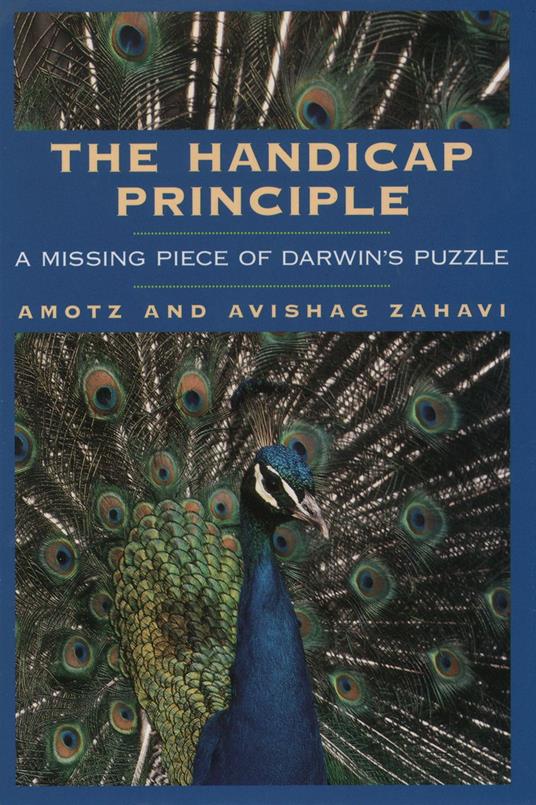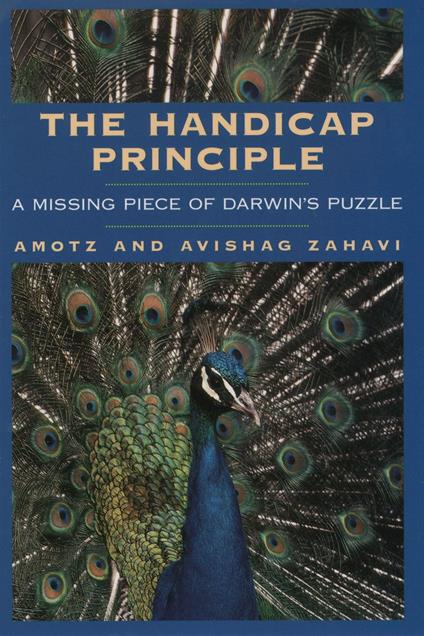L’articolo è stato aggiunto alla lista dei desideri
IBS.it, l'altro eCommerce
The Handicap Principle
Cliccando su “Conferma” dichiari che il contenuto da te inserito è conforme alle Condizioni Generali d’Uso del Sito ed alle Linee Guida sui Contenuti Vietati. Puoi rileggere e modificare e successivamente confermare il tuo contenuto. Tra poche ore lo troverai online (in caso contrario verifica la conformità del contenuto alle policy del Sito).
Grazie per la tua recensione!
Tra poche ore la vedrai online (in caso contrario verifica la conformità del testo alle nostre linee guida). Dopo la pubblicazione per te +4 punti



Tutti i formati ed edizioni
Promo attive (0)
Ever since Darwin, animal behavior has intrigued and perplexed human observers. The elaborate mating rituals, lavish decorative displays, complex songs, calls, dances and many other forms of animal signaling raise fascinating questions. To what degree can animals communicate within their own species and even between species? What evolutionary purpose do such communications serve? Perhaps most importantly, what can animal signaling tell us about our own non-verbal forms of communication? In The Handicap Principle, Amotz and Ashivag Zahavi offer a unifying theory that brilliantly explains many previously baffling aspects of animal signaling and holds up a mirror in which ordinary human behaviors take on surprising new significance. The wide-ranging implications of the Zahavis' new theory make it arguably the most important advance in animal behavior in decades. Based on 20 years of painstaking observation, the Handicap Principle illuminates an astonishing variety of signaling behaviors in animals ranging from ants and ameba to peacocks and gazelles. Essentially, the theory asserts that for animal signals to be effective they must be reliable, and to be reliable they must impose a cost, or handicap, on the signaler. When a gazelle sights a wolf, for instance, and jumps high into the air several times before fleeing, it is signaling, in a reliable way, that it is in tip-top condition, easily able to outrun the wolf. (A human parallel occurs in children's games of tag, where faster children will often taunt their pursuer before running). By momentarily handicapping itself--expending precious time and energy in this display--the gazelle underscores the truthfulness of its signal. Such signaling, the authors suggest, serves the interests of both predator and prey, sparing each the exhaustion of a pointless chase. Similarly, the enormous cost a peacock incurs by carrying its elaborate and weighty tail-feathers, which interfere with food gathering, reliably communicates its value as a mate able to provide for its offspring. Perhaps the book's most important application of the Handicap Principle is to the evolutionary enigma of animal altruism. The authors convincingly demonstrate that when an animal acts altruistically, it handicaps itself--assumes a risk or endures a sacrifice--not primarily to benefit its kin or social group but to increase its own prestige within the group and thus signal its status as a partner or rival. Finally, the Zahavis' show how many forms of non-verbal communication among humans can also be explained by the Handicap Principle. Indeed, the authors suggest that non-verbal signals--tones of voice, facial expressions, body postures--are quite often more reliable indicators of our intentions than is language. Elegantly written, exhaustively researched, and consistently enlivened by equal measures of insight and example, The Handicap Principle illuminates virtually every kind of animal communication. It not only allows us to hear what animals are saying to each other--and to understand why they are saying it--but also to see the enormously important role non-verbal behavior plays in human communication.
L'articolo è stato aggiunto al carrello
Formato:
Gli eBook venduti da IBS.it sono in formato ePub e possono essere protetti da Adobe DRM. In caso di download di un file protetto da DRM si otterrà un file in formato .acs, (Adobe Content Server Message), che dovrà essere aperto tramite Adobe Digital Editions e autorizzato tramite un account Adobe, prima di poter essere letto su pc o trasferito su dispositivi compatibili.
Cloud:
Gli eBook venduti da IBS.it sono sincronizzati automaticamente su tutti i client di lettura Kobo successivamente all’acquisto. Grazie al Cloud Kobo i progressi di lettura, le note, le evidenziazioni vengono salvati e sincronizzati automaticamente su tutti i dispositivi e le APP di lettura Kobo utilizzati per la lettura.
Clicca qui per sapere come scaricare gli ebook utilizzando un pc con sistema operativo Windows
L’articolo è stato aggiunto alla lista dei desideri


